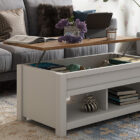Finding answers to the debatable question ‘To Carpet Or Not To Carpet?’ Here’s a quick guide on carpet flooring designs that can help you solve most of your doubts.
Carpets are one of the most popular flooring options in modern/traditional homes. A carpet is defined as a textile floor covering wherein the upper layer of fibre (~pile) is attached to a backing layer (~pad) for increased strength. It can be installed in the bedroom, living room, dining room, patio, playroom, etc.
For better understanding, let’s decode certain carpet terms here – (1) Pile (visible top surface of the carpet which consists of fibre tufts in either cut or uncut loops) (2) Pad (underlay or cushion that is attached beneath the carpets to prolong its life and add cushioning) (3) Density (closeness of the fibres/yarns in the carpet, denser piles. More fibre → More weight → More density → Higher quality) (4) Fibre (basic material that the pile is made up of).
Let’s take a look at some of the benefits and drawbacks of carpet flooring:
- It is versatile as it is available in various fibres (natural/synthetic/combination), grades, cut/pile styles & backings.
- It is a visual and tangible flooring that is comparatively less expensive than tile or hardwood flooring.
- It adds colour and comfort to the designated room/space and directly impacts the indoor air quality.
- It is mostly eco-friendly, absorbs noise, reduces the noise impact and acts as a good heat insulator.
- It is easy to install, recyclable and cost-effective if it is adequately maintained through deep cleaning/regular vacuuming.
- It is a soft and non-slip flooring which reduces the impact of the hard flooring surface on people and furniture alike.
- It provides a conducive environment for dust/dust mites and pests/allergens if not cleaned regularly.
- It can also capture colours and stains, specifically in households with small children and pets.
- It sometimes retains moisture, creating toxic moulds for those with allergies or respiratory problems.
With so many different carpet flooring types available in the market, we know that making a decision won’t be that easy. To spare you the hassle, we’ve listed and categorised them for you based on certain factors. Have a look:
Type Of Carpet Fibres
- Nylon – Artificial, Soft, Non-Porous, Most Widely Available, Durable, Wear-Resistant, Stain-Resistant, Sharper Appearance, Static Buildup-Prone, UV Fading-Resistant. Best For Stairs & Hallways (High-Traffic Areas).
- Wool – Natural, Stain-Resistant, Eco-Friendly, Very Expensive, Finest Quality, Extremely Durable, Heat Insulator, Matte Look, Can Be Easily-Dyed, Can Wear Down With Heavy Traffic Load, Flame-Retardant, Cleans Well.
- Acrylic – Artificial, Not Widely Available, Inexpensive, Abrasion-Resistant, Easy To Clean, Solution-Dyeability, Looks Similar To Wool, Ranks Second To Nylon In Terms of Availability, Sunlight Fading-Resistant.
- Olefin/Polypropylene – Synthetic, Tougher Than Nylon, Less Durable/Resilient, Best For Outdoors/Basements, Moisture-Resistant, Mould-Resistant, Completely Colourfast, Easier To Maintain As Stain Remain On Surface.
- Polyester – Water Soluble Stain-Resistant, Non-Allergenic, Retention of Colour Properties, Colour Clarity, Suitable For Medium-Traffic Areas, Artificial (Plastic Bottles/Recycled Plastics), Luxurious Look, High-Endurance.
- Sisal – Natural, High-Grade Quality, Does Not Trap Dust Or Build Up Static, Strong Woody Fibres, Resistant To Saltwater Deterioration, Durable, Strong, Good Stretchability.
- Cotton – Natural, Inexpensive, Shrinkable, Lightweight, Doesn’t Lie Completely Flat, Reversible, Easily Washable, Not Stain-Resistant, Slides Around Easily (~low pile and flat).
- Silk – Pure Silk Variety (Natural, Strong As Steel, Lightweight, Soft Touch, More Expensive Than Artificial Silk, Shiny Look, More Durable), Artificial Silk Variety (Man-Made, Less Durable, Feel Akin To Rayon & Nylon).
- Triexta – Comparatively New, Synthetic Fibre (Natural Corn Sugar & Petrochemicals), Stain-Resistant, More Durable As Compared To Polyester & Nylon, Soft Touch, Fade-Resistant, Easy To Clean, Colourfast.
- Rayon – Synthetic, Inexpensive, Soft Touch, Shiny Appearance Akin to Silk, Easily Breakable, Weaker As Compared To Other Carpet Fibres, Fades Easily, Poor Resilience, Not Moisture-Resistant, Not Stain-Resistant.

Types Of Carpet Backings/Underlays
Carpet Backing is the padding generally placed under the carpet fibres to give them increased strength, softness and a longer lifespan. It also helps in noise reduction, protects your carpet from daily wear and tear and improves insulation in the room. They are of many types:
- 100% Waterproof-Backing Carpet Flooring protects your subfloors from moisture/water damage through advanced technology wherein the moisture evaporates rather than soaks itself into the tiles/planks. It has odour-resistant fibres and an industrial backing to prevent any damage caused by a spill or stain-related accidents.
- Fusion-Backing Carpet Flooring is made by fusing a fleece layer and woven polypropylene backing. It is resilient and strong yet insulating and soft and easy to install.
- Action-Backing Carpet Flooring is a woven synthetic fabric that is both stable and strong and can be fitted by stretching. It prolongs the life of the floor carpet design. However, it does not provide a non-slip surface.
- Foam/Gel Foam-Backing Carpet Flooring – It is a synthetic material which provides a comfortable surface to walk on and improves the acoustic properties of the space. It is also waterproof and has anti-slip properties.
- PVC-Backing Carpet Flooring – It has dimensional stability, enhances the aesthetics of the installation and provides an impervious moisture barrier. It is more expensive and heavier than rubber-backing but has a long life cycle.
- Soft Plastic-Backing Carpet Flooring – It is manufactured from a plastic weave and has a gentle feel. It extends the life of your floors, however, do not put it in high-humidity areas as it stretches when wet.
- Rubber-Backing Carpet Flooring – It is natural latex carpet backing made of rubber tree sap and provides a non-skid surface. This backing is mainly applied for the stability of the weave to keep it straight.
- Jute-Backing Carpet Flooring – It is the most common type of natural fibre used in carpet backing (~woven) that provides durability and softness. It does not provide a non-slip surface, so you need to be a little careful.
- Cotton-Backing Carpet Flooring – It is an environment-friendly choice and allows for excellent airflow underneath the carpet so the carpet flooring remains odour- and moisture-resistant.

Types Of Carpet Constructions (Pile/Cut Styles)
The carpet construction defines the way the carpet fibres are attached to their pad backing/underlay:
- Loop-Pile Carpets – The fibres/yarn in the carpet are uncut from the surface and are bent into little loops, limited cushioning, stain-resistant, very durable and suitable for high-traffic areas. There are two types of loop-pile carpets:
- Berber-Level Loop Pile Carpets (fibres looped at the same height to give a uniform/even look)
- Multi-Level Loop Pile Carpets (fibres looped at different heights to give a textured/visually dramatic look)
- Cut-Pile Carpets – The fibres/yarn in the carpet are cut from the tips, so there aren’t any loops, softer and denser than loop-pile carpets. They are suitable for living rooms and bedrooms. There are many types of cut-pile carpets:
- Plush Velvety Cut-Pile Carpets (smooth and even texture, formal appearance)
- Saxony Cut-Pile Carpets (longer fibres which are twisted to give the carpet more density and a refined finish)
- Textured Cut-Pile Carpets (fibres that are cut in uneven lengths to create a rough but fuller texture)
- Frieze Cut-Pile Carpets, Cable Cut-Pile Carpets and Shag Cut-Pile Carpets.
- Cut & Loop-Pile Carpets – This carpet features a combination of both cut-pile fibres and loop-pile fibres. It offers the best qualities of both versions, but it is slightly less durable than loop-pile carpets. Many different patterns can be made from it, such as weave patterns, chevron patterns, sculpted patterns, square patterns, swirl patterns, basket patterns, lattice patterns, grid patterns, etc.

Types Of Carpets According To Pile Height/Thickness (Grades)
The pile height/thickness of the carpet is defined as the height of the carpet fibres, excluding the height/thickness of the underlay/backing layer. They are of two types:
- Low-Pile Carpet – Short Fibres | Flat and Denser | Suitable for High Traffic Areas.
- Medium-Pile Carpet – Fibres Taller Than Low-Pile Carpet | Dense | Suitable For Moderate Traffic Areas.
- High-Pile Carpet – Long Fibres | Less Dense Compared To Medium-Pile Carpet | Suitable For Low Traffic Areas

Types Of Carpets As Per The Dyeing Methods
- Continuous-Dyed Carpet Flooring – It is most suitable for woven carpets, and this process is completed during the post-tufting process, which helps achieve solid colours.
- Solution-Dyed Carpet Flooring – It gives the woven carpet a stronger fade, abrasion and stain-resistance since the fibre is dyed before the fibre is woven.

What Factors You Need To Consider For Choosing The Right Carpet Flooring?
- The exact purpose of the room where the carpet flooring needs to be installed. Avoid kitchen/bathrooms.
- The amount of sunlight that the designated room receives and how often the intensity changes during the day.
- The amount of daily traffic that the designated room gets and how close it is to the outdoor/indoor spaces.
- The vacuum cleaning schedule that you prefer to adopt to maintain and prolong your carpets’ lifespan.
- The moisture absorbency and the sound absorbency of the carpets.
- The kind of climatic weather conditions in the geographical location that you live in and the ease of installation.
- The colour/colour mix and pattern/texture selection as per your personality and preferences.
- The strength, density and durability of the actual flooring, carpet flooring and carpet backing.
- The moisture resistance, soil-resistance, flame-resistance, fade-resistance and stain-resistance of the carpet flooring.
- The total cost of the carpet flooring project – material procurement cost, installation cost, maintenance cost, life-cycle costs, etc.

What Are Floor Carpet Tiles, And What All Do You Need To Know About Them?
Floor carpet tiles, also known as modular carpets, are mini sample pieces (~swatches) that are cut from wall-to-wall carpet rolls which can be integrated together to make up a whole floor carpet. Some carpet tile manufacturers also provide carpet tiles of different shapes (Square/Triangles/Hexagons/Rectangular Planks) and sizes (Small/Medium/Large) depending on the needs and requirements of the home incumbents.
Here’s a lowdown on the benefits of carpet tiles:
- They generate minimal or no wastage in the fitting stage.
- They create a comfortable, safe and healthy indoor environment.
- They positively impact the thermal and acoustic properties of the room.
- They can help you express the personality and ambience of the space.
- They are of high quality and give an attractive and modular look to the space.
- They are a comparatively more practical and cheaper alternative to wall-to-wall carpets.
- They offer easy and faster installation as it is convenient to lift and transport (~money and time saving).
- They offer easy customisation and personalisation as you can creatively play around with colours/shapes.
- They are conveniently adjustable and can be laid directly around furniture pieces without displacing them.
- They are only available with pre-installed hardbacks (open-cell/closed-cell cushion backing), so there is no need for underlays.
- They are easy to maintain and care for as the individual carpet tiles can be replaced if damaged and cleaned if soiled.
And not to forget the cons of using carpet tiles too:
- The individual carpet tiles can be visible to an extent depending upon the carpet tile pattern/texture.
- They can show possible wear and tear at the seams if they are placed in a heavy foot traffic area.
- The custom-carpet tile designs are more costly than the standard-carpet tile designs.

Wrapping Up
That’s all there is! We hope that this quick guide has given you enough information and the confidence to make an informed choice when choosing the perfect floor carpet designs for your home. If you still have any queries, contact our expert interior designers’ team at DesignCafe, and they’ll gladly guide you. Good Luck!
If you liked this blog, please check out
living room carpet flooring design ideas
bedroom carpet flooring design ideas
 Select Category
Select Category













